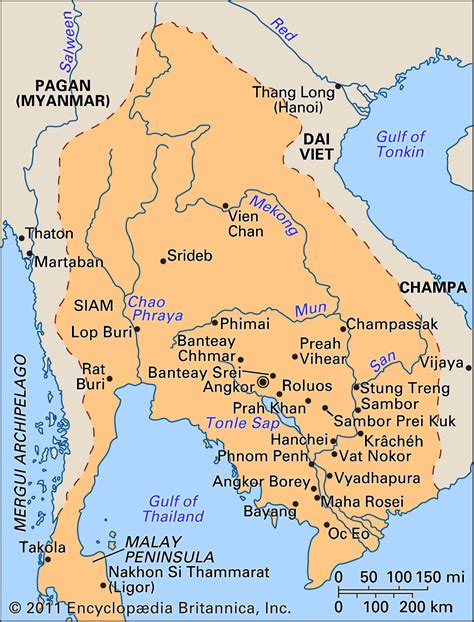Rise of the Khmer Empire
The Khmer Empire emerged in the late 8th century in Southeast Asia, encompassing present-day Cambodia, parts of Vietnam, Laos, and Thailand. The kingdom reached its zenith under King Jayavarman VII (r. 1181-1219), who presided over a period of unprecedented prosperity and territorial expansion.

Timeline of Key Events:
| Date | Event |
|---|---|
| 802 | Jayavarman II crowned as king and declared independence from Java |
| 931 | Completion of the Bakong temple, marking the beginning of Angkorian architecture |
| 1181 | Jayavarman VII ascended to the throne, initiating the golden age of the Khmer Empire |
| 1295 | The Khmer Empire declined due to invasions and environmental factors |
Geographic Reach and Influence
At its peak, the Khmer Empire controlled a vast territory, stretching from the Gulf of Thailand to the Mekong Delta. The kingdom’s influence extended to neighboring states and beyond. Khmer art, architecture, and religious practices left a lasting legacy throughout Southeast Asia.
Size and Population:
- Area: Approximately 400,000 square kilometers
- Population: Estimated 1-3 million inhabitants
Religious and Architectural Legacy
The Khmer Empire was a predominantly Hindu-Buddhist society. The religion played a central role in the kingdom’s politics, social structure, and artistic expression.
Angkor Wat: A Monumental Religious Complex
- Constructed during the reign of Suryavarman II as a Hindu temple dedicated to Vishnu
- Repurposed as a Buddhist temple in the 13th century
- UNESCO World Heritage Site, renowned for its intricate bas-reliefs and iconic towers
Economic and Social Structure
The Khmer Empire’s economy thrived on agriculture, with rice cultivation as the primary crop. The kingdom also engaged in trade with China, India, and the Middle East.
Agriculture and Infrastructure
- Extensive irrigation systems supported rice production
- A network of canals and roads facilitated trade and transportation
Social Stratification and Kingship
- The king was considered the embodiment of the gods
- The elite class consisted of nobles, priests, and officials
- Commoners worked as farmers, artisans, and laborers
Decline and Fall
The Khmer Empire declined in the 13th century due to a combination of factors, including invasions from neighboring states and environmental changes.
Invasions and Climate Change
- Invasion by the Thai kingdom of Ayutthaya in the 13th and 14th centuries
- Prolonged drought and shifts in river courses contributed to the decline
Legacy and Impact
Despite its decline, the Khmer Empire left a profound legacy on the region. Its magnificent temples and artwork continue to inspire awe and wonder among visitors.
Historical Significance
The Khmer Empire holds great significance in AP World History for its:
- Flourishing civilization and cultural achievements
- Influence on the development of Southeast Asian art and architecture
- Role in the spread of Hinduism and Buddhism
- Example of how environmental factors can shape the fate of empires
Tables
Table 1: Khmer Kings and Reigns
| King | Reign |
|---|---|
| Jayavarman II | 802-869 |
| Suryavarman II | 1113-1150 |
| Jayavarman VII | 1181-1219 |
Table 2: Khmer Temples and Religious Sites
| Temple | Location | Religion |
|---|---|---|
| Angkor Wat | Angkor, Cambodia | Hindu-Buddhist |
| Bayon | Angkor, Cambodia | Buddhist |
| Ta Prohm | Angkor, Cambodia | Hindu |
Table 3: Khmer Economy and Agriculture
| Resource | Description |
|---|---|
| Rice | Staple crop and primary source of food |
| Silk | Produced and traded for luxury goods |
| Ivory | Obtained from elephants and exported to China |
Table 4: Khmer Social Structure
| Class | Description |
|---|---|
| King | God-king and absolute authority |
| Nobility | Elite class consisting of officials and military leaders |
| Priesthood | Responsible for religious ceremonies and rituals |
| Commoners | Farmers, artisans, and laborers |
